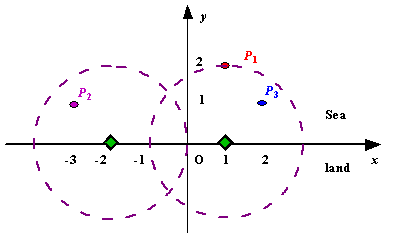|
Radar Installation
Description
Assume the coasting is an infinite straight line. Land is in one side of coasting, sea in the other. Each small island is a point locating in the sea side. And any radar installation, locating on the coasting, can only cover d distance, so an island in the sea can be covered by a radius installation, if the distance between them is at most d.
We use Cartesian coordinate system, defining the coasting is the x-axis. The sea side is above x-axis, and the land side below. Given the position of each island in the sea, and given the distance of the coverage of the radar installation, your task is to write a program to find the minimal number of radar installations to cover all the islands. Note that the position of an island is represented by its x-y coordinates. 
Figure A Sample Input of Radar Installations Input
The input consists of several test cases. The first line of each case contains two integers n (1<=n<=1000) and d, where n is the number of islands in the sea and d is the distance of coverage of the radar installation. This is followed by n lines each containing two integers representing the coordinate of the position of each island. Then a blank line follows to separate the cases.
The input is terminated by a line containing pair of zeros Output
For each test case output one line consisting of the test case number followed by the minimal number of radar installations needed. "-1" installation means no solution for that case.
Sample Input 3 2 1 2 -3 1 2 1 1 2 0 2 0 0 Sample Output Case 1: 2 Case 2: 1 Source |
一道挺经典的贪心。每个点可以在x轴覆盖一个区间,然后按x从小到大排序 , 找重叠区域即可。
#include <cstdio>
#include <cmath>
#include <algorithm>
#include <iostream>
#include <cstring>
#include <map>
#include <string>
#include <stack>
#include <cctype>
#include <vector>
#include <queue>
#include <set>
#include <utility>
#include <cassert>
using namespace std;
///#define Online_Judge
#define outstars cout << "***********************" << endl;
#define clr(a,b) memset(a,b,sizeof(a))
#define lson l , m , rt << 1
#define rson m + 1 , r , rt << 1 | 1
#define mk make_pair
#define FOR(i , x , n) for(int i = (x) ; i < (n) ; i++)
#define FORR(i , x , n) for(int i = (x) ; i <= (n) ; i++)
#define REP(i , x , n) for(int i = (x) ; i > (n) ; i--)
#define REPP(i ,x , n) for(int i = (x) ; i >= (n) ; i--)
const int MAXN = 1000 + 50;
const int sigma_size = 26;
const long long LLMAX = 0x7fffffffffffffffLL;
const long long LLMIN = 0x8000000000000000LL;
const int INF = 0x7fffffff;
const int IMIN = 0x80000000;
#define eps 1e-8
const int MOD = (int)1e9 + 7;
typedef long long LL;
const double PI = acos(-1.0);
typedef double D;
typedef pair<int , int> pi;
///#pragma comment(linker, "/STACK:102400000,102400000")
struct Point
{
D x , y;
}a[MAXN];
bool cmp(Point a , Point b)
{
return a.x < b.x;
}
int main()
{
// freopen("heritage.in","r",stdin);
// freopen("heritage.out","w",stdout);
int n , d;
int kase = 1;
while(~scanf("%d%d" , &n , &d)&&(n || d))
{
printf("Case %d: " , kase++);
int ok = 1;
FOR(i , 0 , n)
{
int xxx , yyy;
scanf("%d%d" , &xxx , &yyy);
if(abs(yyy) > d)ok = 0;
a[i].x = xxx * 1.000 - sqrt(d * d * 1.000 - yyy * yyy * 1.000);
a[i].y = xxx * 1.000 + sqrt(d * d * 1.000 - yyy * yyy * 1.000);
}
if(!ok)printf("-1\n");
else
{
sort(a , a + n , cmp);
int cnt = 1;
D tmp = a[0].y;
FOR(i , 1, n)
{
if(a[i].y < tmp)
{
tmp = a[i].y;
}
else if(a[i].x > tmp)
{
cnt++;
tmp = a[i].y;
}
}
printf("%d\n" , cnt);
}
}
return 0;
}





















 1186
1186

 被折叠的 条评论
为什么被折叠?
被折叠的 条评论
为什么被折叠?








